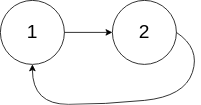LeetCode-141. 环形链表
题目来源
题目详情
给你一个链表的头节点 head ,判断链表中是否有环。
如果链表中有某个节点,可以通过连续跟踪 next 指针再次到达,则链表中存在环。 为了表示给定链表中的环,评测系统内部使用整数 pos 来表示链表尾连接到链表中的位置(索引从 0 开始)。注意:pos 不作为参数进行传递。仅仅是为了标识链表的实际情况。
如果链表中存在环 ,则返回 true 。 否则,返回 false 。
示例 1:

输入: head = [3,2,0,-4], pos = 1
输出: true
解释: 链表中有一个环,其尾部连接到第二个节点。
示例 2:

输入: head = [1,2], pos = 0
输出: true
解释: 链表中有一个环,其尾部连接到第一个节点。
示例 3:

输入: head = [1], pos = -1
输出: false
解释: 链表中没有环。
提示:
- 链表中节点的数目范围是
[0, 104] -105 <= Node.val <= 105pos为-1或者链表中的一个 有效索引 。
进阶: 你能用 O(1)(即,常量)内存解决此问题吗?
相似题目
题解分析
解法一:快慢指针-复杂版
/**
* Definition for singly-linked list.
* class ListNode {
* int val;
* ListNode next;
* ListNode(int x) {
* val = x;
* next = null;
* }
* }
*/
public class Solution {
public boolean hasCycle(ListNode head) {
if(head == null){
return false;
}
ListNode slow = head;
if(slow.next == slow){
return true;
}
if(slow.next == null){
return false;
}
ListNode fast = slow.next.next;
while(fast != null && fast.next != null && slow != fast){
slow = slow.next;
fast = fast.next.next;
}
if(fast == null || fast.next == null){
return false;
}
return true;
}
}
解法二:快慢指针-精简版
- 从解法一我们可以看到,这种解法十分复杂,需要很多的null判断。
- 实际上,这些空判断可以在循环里面判断,我们前面其实并不需要初始化fast指针为head.next.next,这步同样可以在循环中完成。
- 需要注意的是,我们的while循环的条件是fast != null,那我们可能会有一个疑问,为什么不将fast.next != null也加上去呢?其实这里有可能slow会等于fast.next。
- 我们的思路是每次先走fast(往前走两步),再和没有走之前的slow进行比较,如果相同则直接返回,否则继续走slow(往前走一步)。
/**
* Definition for singly-linked list.
* class ListNode {
* int val;
* ListNode next;
* ListNode(int x) {
* val = x;
* next = null;
* }
* }
*/
public class Solution {
public boolean hasCycle(ListNode head) {
ListNode slow = head, fast = head;
while(fast != null){
fast = fast.next;
if(fast != null){
fast = fast.next;
}
if(slow == fast){
return true;
}
slow = slow.next;
}
return false;
}
}
/**
* Definition for singly-linked list.
* class ListNode {
* int val;
* ListNode next;
* ListNode(int x) {
* val = x;
* next = null;
* }
* }
*/
public class Solution {
public boolean hasCycle(ListNode head) {
ListNode slow = head, fast = head;
while(fast != null && fast.next != null){
fast = fast.next.next;
if(slow == fast){
return true;
}
slow = slow.next;
}
return false;
}
}
Either Excellent or Rusty



【推荐】国内首个AI IDE,深度理解中文开发场景,立即下载体验Trae
【推荐】编程新体验,更懂你的AI,立即体验豆包MarsCode编程助手
【推荐】抖音旗下AI助手豆包,你的智能百科全书,全免费不限次数
【推荐】轻量又高性能的 SSH 工具 IShell:AI 加持,快人一步
· 单线程的Redis速度为什么快?
· 展开说说关于C#中ORM框架的用法!
· Pantheons:用 TypeScript 打造主流大模型对话的一站式集成库
· SQL Server 2025 AI相关能力初探
· 为什么 退出登录 或 修改密码 无法使 token 失效
2021-02-08 剑指 Offer 49. 丑数 + 小根堆 + 动态规划
2021-02-08 剑指 Offer 48. 最长不含重复字符的子字符串 + 动态规划 + 哈希表 + 双指针 + 滑动窗口
2021-02-08 剑指 Offer 46. 把数字翻译成字符串 + 动态规划
2021-02-08 剑指 Offer 45. 把数组排成最小的数
2021-02-08 剑指 Offer 44. 数字序列中某一位的数字 + 找规律 + 数位
2021-02-08 剑指 Offer 43. 1~n 整数中 1 出现的次数 + 数位模拟 + 思维
2021-02-08 剑指 Offer 41. 数据流中的中位数 + 堆 + 优先队列